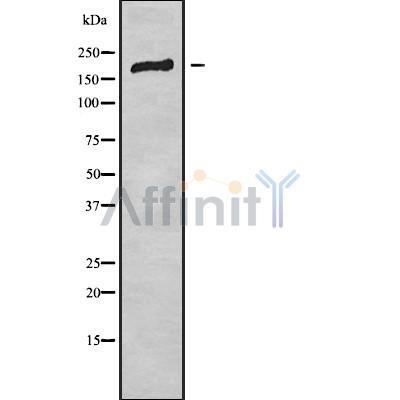BAI2 Antibody - #DF10200
| Product: | BAI2 Antibody |
| Catalog: | DF10200 |
| Description: | Rabbit polyclonal antibody to BAI2 |
| Application: | WB IHC |
| Reactivity: | Human, Mouse |
| Prediction: | Pig, Bovine, Horse, Sheep, Rabbit, Dog, Chicken, Xenopus |
| Mol.Wt.: | 173 kDa; 173kD(Calculated). |
| Uniprot: | O60241 |
| RRID: | AB_2840779 |
Related Downloads
Protocols
Product Info
*The optimal dilutions should be determined by the end user. For optimal experimental results, antibody reuse is not recommended.
*Tips:
WB: For western blot detection of denatured protein samples. IHC: For immunohistochemical detection of paraffin sections (IHC-p) or frozen sections (IHC-f) of tissue samples. IF/ICC: For immunofluorescence detection of cell samples. ELISA(peptide): For ELISA detection of antigenic peptide.
Cite Format: Affinity Biosciences Cat# DF10200, RRID:AB_2840779.
Fold/Unfold
Brain Specific Angiogenesis Inhibitor 2;
Immunogens
A synthesized peptide derived from human BAI2, corresponding to a region within C-terminal amino acids.
Strongly expressed in brain. Also detected in heart, thymus, skeletal muscle, and different cell lines.
- O60241 AGRB2_HUMAN:
- Protein BLAST With
- NCBI/
- ExPASy/
- Uniprot
MENTGWMGKGHRMTPACPLLLSVILSLRLATAFDPAPSACSALASGVLYGAFSLQDLFPTIASGCSWTLENPDPTKYSLYLRFNRQEQVCAHFAPRLLPLDHYLVNFTCLRPSPEEAVAQAESEVGRPEEEEAEAAAGLELCSGSGPFTFLHFDKNFVQLCLSAEPSEAPRLLAPAALAFRFVEVLLINNNNSSQFTCGVLCRWSEECGRAAGRACGFAQPGCSCPGEAGAGSTTTTSPGPPAAHTLSNALVPGGPAPPAEADLHSGSSNDLFTTEMRYGEEPEEEPKVKTQWPRSADEPGLYMAQTGDPAAEEWSPWSVCSLTCGQGLQVRTRSCVSSPYGTLCSGPLRETRPCNNSATCPVHGVWEEWGSWSLCSRSCGRGSRSRMRTCVPPQHGGKACEGPELQTKLCSMAACPVEGQWLEWGPWGPCSTSCANGTQQRSRKCSVAGPAWATCTGALTDTRECSNLECPATDSKWGPWNAWSLCSKTCDTGWQRRFRMCQATGTQGYPCEGTGEEVKPCSEKRCPAFHEMCRDEYVMLMTWKKAAAGEIIYNKCPPNASGSASRRCLLSAQGVAYWGLPSFARCISHEYRYLYLSLREHLAKGQRMLAGEGMSQVVRSLQELLARRTYYSGDLLFSVDILRNVTDTFKRATYVPSADDVQRFFQVVSFMVDAENKEKWDDAQQVSPGSVHLLRVVEDFIHLVGDALKAFQSSLIVTDNLVISIQREPVSAVSSDITFPMRGRRGMKDWVRHSEDRLFLPKEVLSLSSPGKPATSGAAGSPGRGRGPGTVPPGPGHSHQRLLPADPDESSYFVIGAVLYRTLGLILPPPRPPLAVTSRVMTVTVRPPTQPPAEPLITVELSYIINGTTDPHCASWDYSRADASSGDWDTENCQTLETQAAHTRCQCQHLSTFAVLAQPPKDLTLELAGSPSVPLVIGCAVSCMALLTLLAIYAAFWRFIKSERSIILLNFCLSILASNILILVGQSRVLSKGVCTMTAAFLHFFFLSSFCWVLTEAWQSYLAVIGRMRTRLVRKRFLCLGWGLPALVVAVSVGFTRTKGYGTSSYCWLSLEGGLLYAFVGPAAVIVLVNMLIGIIVFNKLMARDGISDKSKKQRAGSERCPWASLLLPCSACGAVPSPLLSSASARNAMASLWSSCVVLPLLALTWMSAVLAMTDRRSVLFQALFAVFNSAQGFVITAVHCFLRREVQDVVKCQMGVCRADESEDSPDSCKNGQLQILSDFEKDVDLACQTVLFKEVNTCNPSTITGTLSRLSLDEDEEPKSCLVGPEGSLSFSPLPGNILVPMAASPGLGEPPPPQEANPVYMCGEGGLRQLDLTWLRPTEPGSEGDYMVLPRRTLSLQPGGGGGGGEDAPRARPEGTPRRAAKTVAHTEGYPSFLSVDHSGLGLGPAYGSLQNPYGMTFQPPPPTPSARQVPEPGERSRTMPRTVPGSTMKMGSLERKKLRYSDLDFEKVMHTRKRHSELYHELNQKFHTFDRYRSQSTAKREKRWSVSSGGAAERSVCTDKPSPGERPSLSQHRRHQSWSTFKSMTLGSLPPKPRERLTLHRAAAWEPTEPPDGDFQTEV
Predictions
Score>80(red) has high confidence and is suggested to be used for WB detection. *The prediction model is mainly based on the alignment of immunogen sequences, the results are for reference only, not as the basis of quality assurance.
High(score>80) Medium(80>score>50) Low(score<50) No confidence
Research Backgrounds
Orphan G-protein coupled receptor involved in cell adhesion and probably in cell-cell interactions. Activates NFAT-signaling pathway, a transcription factor, via the G-protein GNAZ. Involved in angiogenesis inhibition (By similarity).
Autoproteolytic processes at the GPS domain; this cleavage modulates receptor activity. Additionally, furin is involved in the cleavage at another site, in the middle of the extracellular domain, generating a soluble fragment.
Glycosylated.
Cell membrane>Multi-pass membrane protein.
Strongly expressed in brain. Also detected in heart, thymus, skeletal muscle, and different cell lines.
Belongs to the G-protein coupled receptor 2 family. Adhesion G-protein coupled receptor (ADGR) subfamily.
Restrictive clause
Affinity Biosciences tests all products strictly. Citations are provided as a resource for additional applications that have not been validated by Affinity Biosciences. Please choose the appropriate format for each application and consult Materials and Methods sections for additional details about the use of any product in these publications.
For Research Use Only.
Not for use in diagnostic or therapeutic procedures. Not for resale. Not for distribution without written consent. Affinity Biosciences will not be held responsible for patent infringement or other violations that may occur with the use of our products. Affinity Biosciences, Affinity Biosciences Logo and all other trademarks are the property of Affinity Biosciences LTD.
